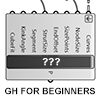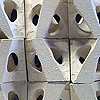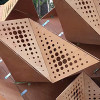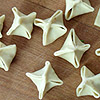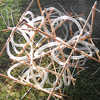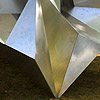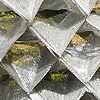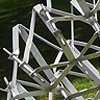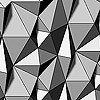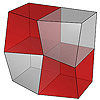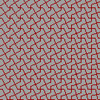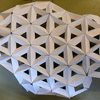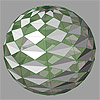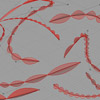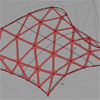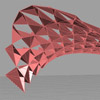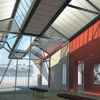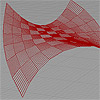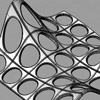In this fourth episode of Grasshopper for Beginners, the explanation of the graphical user interface continued. We call the data flow diagrams definitions. GH definitions are rendered on a large blank screen area called canvas. We can zoom in and out (zoom) the canvas with the middle mouse wheel. Or pan sideways by holding down the right mouse button. Tabs and panels are menus where all the components of the […]
Posts with the keyword component
In the last semester’s mid-term project of Computation-based Basic Design 2, we experimented with the casting method for studying solids and voids. Students worked in groups of four. First, they designed a set of components within a 10cm bounding cube. These cubes represent 1m3 on a 1:10 scale. After that, they multiplied them into a system of voids with a function for human use. They fabricated at least 24 pieces […]
Another well-organized group of students produced this self-standing structure in only a couple of days. This group joined the same 8mm wooden plates into a set of components of 8-sided polyhedra. Then, they joined these components in a fashion that the macro form emerged from the angles of their geometry. Below are some of the pictures of their production phases: The final prototype Some phases of the production Model of […]
A mid-15th-century Ottoman recipe, mantı is filled with pounded lamb and crushed chickpeas, steamed, and served topped with yogurt mixed with crushed garlic and sprinkled with sumac. In modern Turkish cuisine, mantı is typically served topped with yogurt and garlic, and spiced with red pepper powder and melted butter, and with ground sumac and/or dried mint. Although there are many different variations of mantı in terms of shape and way of […]
Here is the “hose” group of the İstanbul Bilgi University Faculty of Architecture Basic Design project. Although they were challenged with a nearly impossible mission, trying to make a structural system out of hoses, they simply did it well. After a tremendous effort on the possible combinations of hoses and wooden sticks, they found sophisticated components, utilizing the positive potentials of both materials. This year, we allowed them to develop […]
Below is one of the fourteen final projects of the freshman year Basic Design studio in İstanbul Bilgi University Faculty of Architecture. The component is made of folded aluminum sheets. Students insist that this is the most optimal solution to the problem of polyhedra in a component-based structure. They experimented with this shape a lot and tried their best to make one that has similar triangular faces on different sides, […]
This group used aluminum expanded mesh in order to test its balance between structural capacity and weight. They folded different-sized sheets to create components, then assembled them creating a span of 2,5 meters approx. They managed to control the macro form by manipulating the component precisely. This year, the dominant discussion among the studio instructors was the context; how to include (or not include), manage, and think about the context, […]
The material system of group 2 at İBU Basic Design project was based on a component developed using tensegrity forces on aluminum bands. Although it was hard to maintain structural solidity with the heavy material, they proved that letting aluminum fly over a predefined distance (at least for a limited time) is possible. *Students: Büşra Kavuk, Büşra Pamuk, Mustafa Sert, Ahmet Evci, Safa Bayam, Sibel Küçükcoşkun, Gizem Işıkalp, Serenay Erbektaş, […]
Here are some student works about the parametric wall exercise I briefly explained here along with a Grasshopper implementation of the core wall definition. Students are expected to design their own brick and compose it in a way that generates a seamless wall surface. Ömer Kirazoğlu Osman Can Sözüneri Seda Öznal (slightly out of requirement but very interesting) Adnan Faysal Altunbozar Özgüç Bertuğ Çapunaman
This is a first-year design computing problem we studied last month. It is a simple parametric wall exercise introduced by Mete Tüneri. Creating a simple definition of a building brick to be placed on a straight path, and then manipulating the path to reform different variations of the brick. This aims to introduce a fundamental concept of associativity in contemporary architectural geometry and design computing. Students are then encouraged to […]
Is it possible to model a two-way parquet deformation using only native components of Grasshopper? In this definition, I limited myself to 10 of them. Parquet deformations are a very interesting and pedagogical topic to teach some of the basics of contemporary parametric modeling. This post explains a minimal parquet deformations algorithm in Grasshopper. However, this has its own limitations. You will see that the definition generates the attractor graph […]
This was last year, Salih Küçüktuna had organized a one-day exercise at the first-year Basic Design studio. It was a quite successful event, both emphasizing the fundamentals of contemporary design ideas and also being very pedagogical regarding the method. We asked students to bring blank regular business cards and staples to the studio. The main idea was to design a component and multiply it to create a structure that spans […]
After Puzzling, I tried to establish more of Escher’s basic grid transformations using Grasshopper’s native components. This definition simulates Escher’s transformation of four-cornered grids. The postulate is based on the fact that every quadrilateral (or triangular) planar shape can create regular tessellations without gaps or overlaps. In the traditional method, this tessellation is achieved by rotating the shape 180 degrees and copying afterward. However, in Grasshopper we simply define the […]
Today, we’ve discussed ways of subdividing entities to create parametric definitions. Curves can be divided into segments, creating snake-like object definitions. This exercise is important regarding the management of data. Vectors and planes are used as reference entities here. Nowadays, it became clear to me that, reference planes are very important because they both include reference points and related vectors as well. The definition studied in this post includes a curve […]
This is the old-method Parametric Truss definition. Interestingly this quickly became a solid solution, used and taught for years. I couldn’t find a better answer yet. As Grasshopper updates, some of the components in this definition change but the overall structure remains. Subdivision of a free-form surface and addition of geometric components has, of course, a wide range of alternatives. Maybe we should combine this with different problems and solutions […]
In this experiment, I’m trying to use data recorder to change components on a surface. The component part is a standart triangular construction, but the attractor points are defined by a 2D slider that is connected to a data recorder. Data recorder remembers last 15 points, while you move the 2d slider, last 15 points are projected on the base surface. This creates an illusion as if a “snake” game […]
This study includes three main topics related to the basics of Grasshopper. The first one is the surface subdivision, the parametric definition of a surface component, that is, in this case, a simple pyramidal object. The second thing is the associative behavior of surface components with an external parameter, that is another entity in space; a curve. Traditionally, this is simply demonstrated by 1) finding the area centroids of each […]
This was a design competition of a precast concrete roof system. My design proposal was a modular and variable structure for İstanbul’s old bus station, converted to art galleries. However, this project was developed purely by hand-sketches, I’m planning to create an envelope of alternatives by creating a parametric model. Each module is proposed to be converted differently in order to meet various functions such as single or double module […]
This is a basic formation of component-based design in a dataflow environment. A double-curved surface is subdivided and re-constructed using straight sections. Parametric model of a surface construction by variable components. The main data list of subsurfaces are distributed into four distinct lists, that will be used to construct lines out of double-curved quadrilateral faces. Such definitions could be further advanced by adding a precise fabrication detail. Parametric definition can […]
The cellular canopy is an anonymous tutorial on the history recording capability of Rhino. I’ve been using a “pedagogical” version of this tutorial as an educational tool on the introduction to Grasshopper and Parametric Modeling for architects. The interesting thing with such exercises is they quickly attract students’ attention to the process of designing, in other words, “designing the design process”; is one of the first things we should emphasize […]

